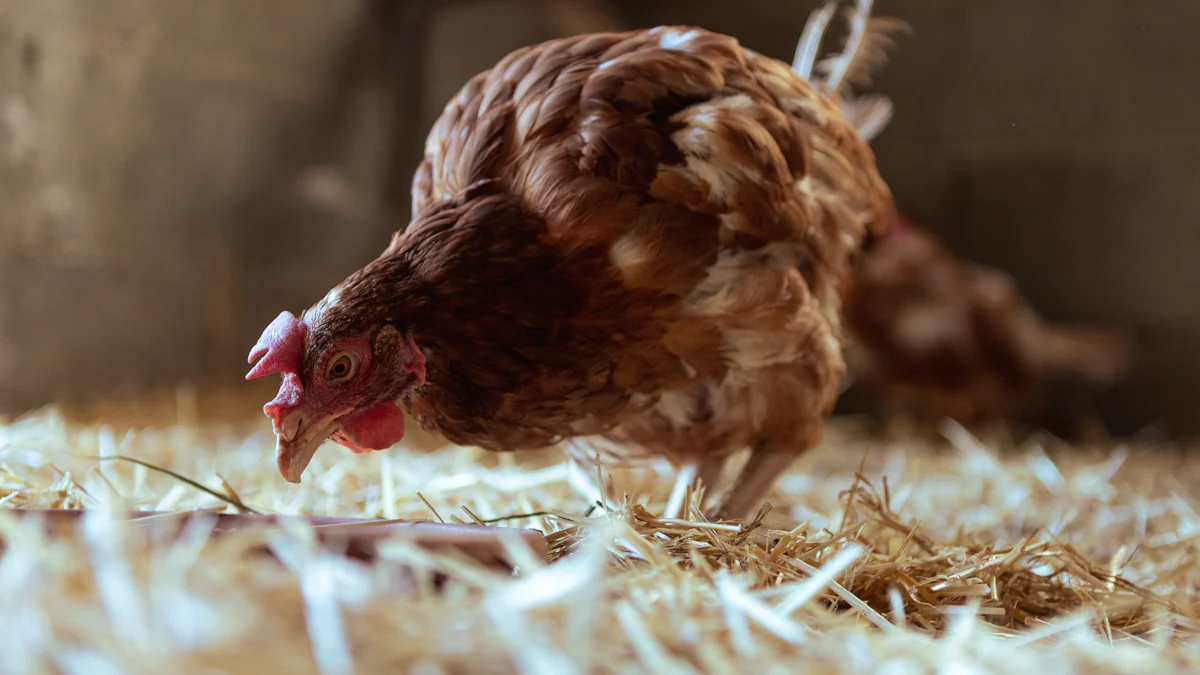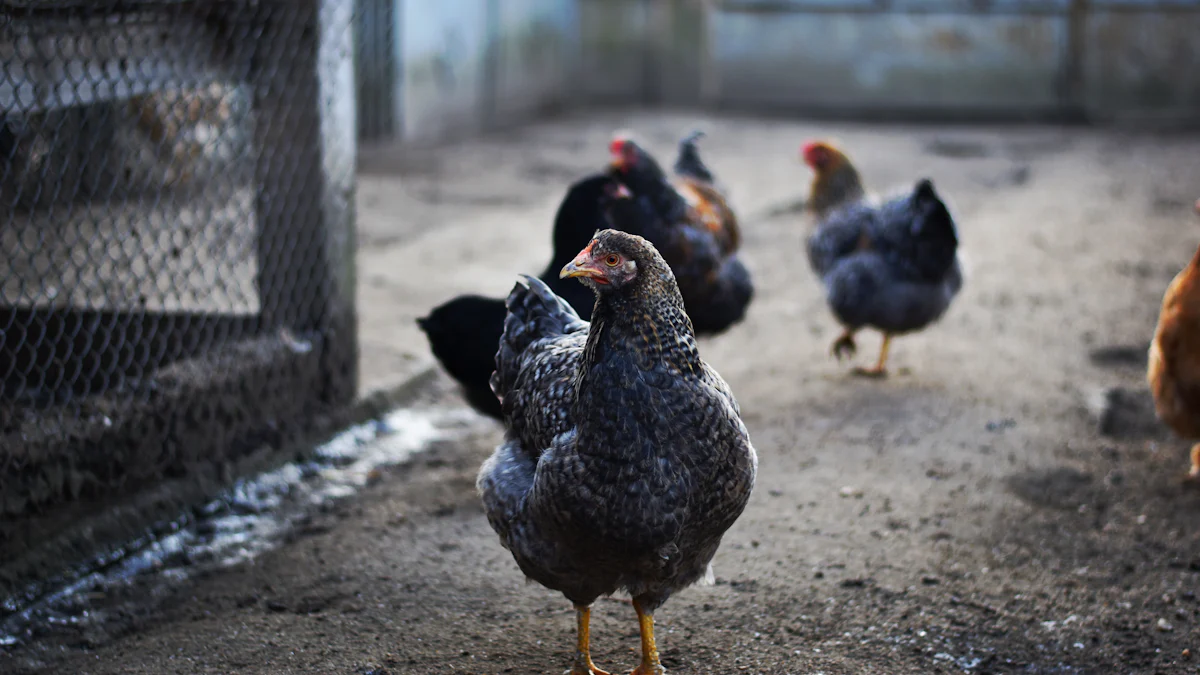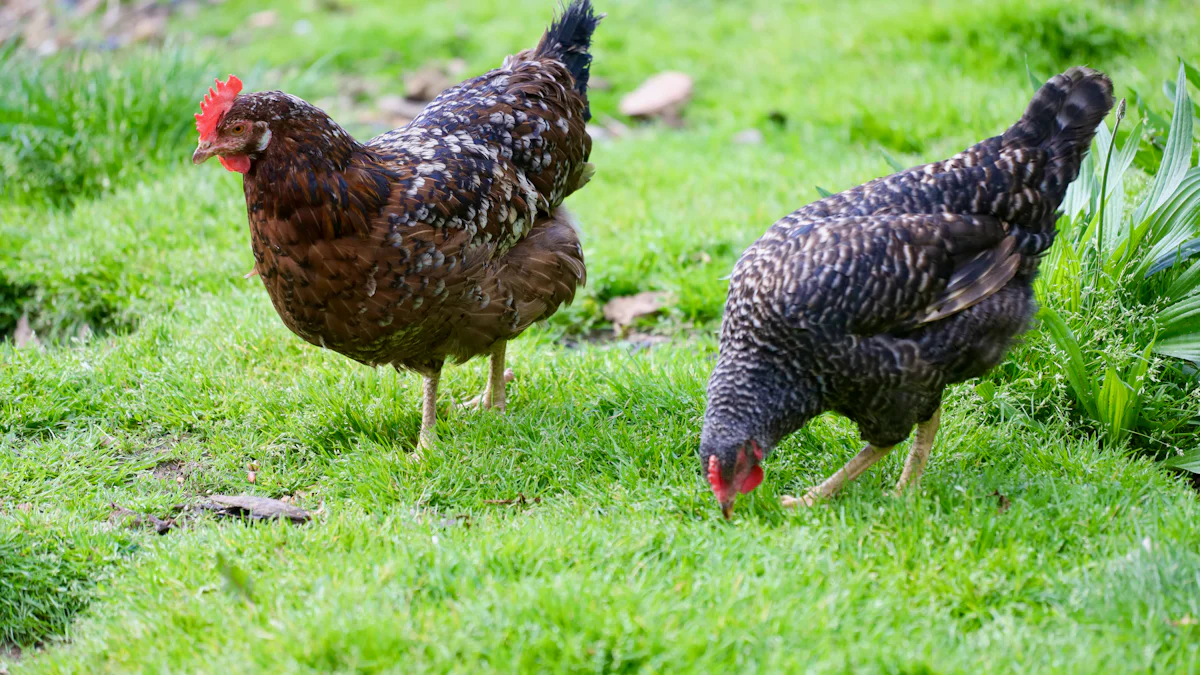
Chickens can’t resist dried mealworms. These tiny treats pack a punch with their rich taste and high nutritional value. They’re loaded with protein, fats, and essential nutrients that your flock craves. Feeding chickens dried mealworms not only satisfies their appetite but also boosts their energy levels. It’s a simple way to keep them happy and healthy. Plus, the crunchy texture mimics their natural foraging instincts, making mealworms an irresistible snack they’ll always come running for.
Key Takeaways
- Dried mealworms are a protein powerhouse, containing 50-53% protein, essential for your chickens’ growth and egg production.
- Feeding mealworms during molting season supports feather regrowth, leading to healthier and shinier feathers.
- These treats provide a source of energy, especially beneficial during colder months when chickens require more calories.
- Scattering mealworms on the ground encourages natural foraging behavior, keeping your chickens active and engaged.
- Hand-feeding mealworms builds trust and strengthens your bond with your flock, making them more comfortable around you.
- Mixing mealworms with regular feed adds excitement to mealtime while ensuring a balanced diet for your chickens.
- Consider alternatives like fresh mealworms or black soldier fly larvae to diversify your chickens’ diet and enhance their nutrition.
The Nutritional Benefits of Feeding Chickens Dried Mealworms

High Protein Content
Protein plays a vital role in your chickens’ health. Dried mealworms are packed with protein, containing around 50-53%. This makes them an excellent choice for boosting your flock’s diet. Protein helps your chickens grow strong muscles and supports their overall development. If you have laying hens, they need extra protein to produce healthy eggs. Feeding chickens dried mealworms ensures they get the protein they need to thrive. It’s a simple way to keep your birds in top shape.
Promotes Feather Health
Feathers are more than just a pretty feature. They protect your chickens from weather and help regulate body temperature. Feathers are made mostly of keratin, a protein. When your chickens molt, they need extra protein to grow new feathers. Dried mealworms provide that boost. Feeding chickens dried mealworms during molting season can speed up feather regrowth and improve their overall appearance. You’ll notice shinier, healthier feathers in no time.
A Source of Energy
Chickens are active creatures. They scratch, peck, and roam all day. To keep up with this energy demand, they need a diet rich in nutrients. Dried mealworms are not just high in protein; they also contain healthy fats. These fats give your chickens the energy they need to stay active and happy. Feeding chickens dried mealworms is especially helpful during colder months when they burn more calories to stay warm. A handful of mealworms can make a big difference in keeping your flock energized.
Practical Tips for Feeding Chickens Dried Mealworms

Scattering on the Ground
Scattering dried mealworms on the ground is one of the easiest ways to feed your chickens. This method encourages their natural foraging instincts. Chickens love to scratch and peck at the ground, and scattering mealworms mimics how they would search for food in the wild. It keeps them physically active and mentally engaged. You’ll notice how excited they get as they hunt for these tasty treats. Plus, this approach helps reduce boredom and stress within your flock. Just make sure to scatter the mealworms in a clean area to avoid contamination.
Hand-Feeding
Hand-feeding dried mealworms is a great way to bond with your chickens. It builds trust and makes them more comfortable around you. Simply hold a small handful of mealworms and let your chickens peck them directly from your hand. They’ll quickly associate you with their favorite treat, and you might even find them running to greet you whenever you approach. This method works well if you’re trying to tame shy chickens or strengthen your relationship with your flock. Remember to stay patient and calm, especially if it’s their first time being hand-fed.
Mixing with Regular Feed
Mixing dried mealworms with your chickens’ regular feed is another practical option. This ensures they get a balanced diet while enjoying their favorite snack. Sprinkle a handful of mealworms into their feed and mix it well. Your chickens will eagerly dig through the feed to find the mealworms, making mealtime more exciting for them. This method is especially useful if you want to introduce mealworms gradually or ensure every chicken gets a fair share. It’s a simple way to combine nutrition with a bit of fun.
Using Mealworms as a Training Tool
Dried mealworms aren’t just a tasty treat for your chickens—they can also be a powerful training tool. If you’re looking to teach your flock new behaviors or simply get them to come when called, mealworms can make the process easier and more enjoyable for both you and your birds.
Start by using mealworms as a reward. For example, if you want your chickens to return to their coop at the end of the day, shake a container filled with mealworms while calling them. The sound will grab their attention, and they’ll quickly associate it with their favorite snack. Over time, they’ll learn to respond to your call, making it much simpler to gather them when needed.
You can also use mealworms to encourage shy or hesitant chickens to approach you. Hold a small handful of mealworms in your palm and stay still. Let them come to you at their own pace. This builds trust and helps them feel more comfortable around you. Once they realize you’re the source of their favorite treat, they’ll become more confident and eager to interact.
Training with mealworms doesn’t have to stop there. You can teach your chickens to follow you, hop onto a perch, or even perform simple tricks. Keep training sessions short and positive. Always reward them immediately with a few mealworms to reinforce the behavior. This keeps them motivated and excited to learn.
Using mealworms as a training tool not only strengthens your bond with your flock but also makes managing them easier. Whether you’re guiding them back to the coop or teaching them new skills, feeding chickens dried mealworms turns training into a fun and rewarding experience.
Alternatives to Feeding Chickens Dried Mealworms
Fresh Mealworms
Fresh mealworms offer a natural and nutrient-packed alternative to their dried counterparts. These live insects are rich in protein and moisture, making them an excellent treat for your flock. Chickens love the movement of fresh mealworms, which triggers their hunting instincts. Watching them chase and peck at these wriggling snacks can be entertaining for you and stimulating for your birds.
If you’re considering fresh mealworms, you can either purchase them from a supplier or raise them yourself. Raising mealworms at home is surprisingly simple and cost-effective. It also ensures a steady supply of fresh, high-quality protein for your chickens. Just remember to feed fresh mealworms in moderation to maintain a balanced diet for your flock.
Black Soldier Fly Larvae
Black soldier fly larvae (BSFL) are another fantastic protein-rich option for your chickens. These larvae are packed with essential nutrients, including calcium, which is crucial for laying hens. Feeding your chickens BSFL can help improve eggshell quality and overall health.
One of the best things about BSFL is their sustainability. They can be raised on food scraps, making them an eco-friendly choice for chicken owners. You can buy them dried or fresh, depending on your preference. Chickens find BSFL just as irresistible as mealworms, so they’ll eagerly gobble them up. Incorporating BSFL into your flock’s diet adds variety and supports their nutritional needs.
Other Protein-Rich Treats
If you’re looking for more variety, there are plenty of other protein-rich treats your chickens will enjoy. Here are a few options:
- Cooked Eggs: Scrambled or hard-boiled eggs are a great source of protein and easy to prepare. Chickens love the taste, and it’s a good way to use up surplus eggs.
- Fish or Seafood Scraps: Small amounts of cooked fish or shrimp provide a protein boost. Just avoid seasoning or sauces that could harm your flock.
- Legumes: Cooked beans, lentils, or peas are plant-based protein sources that chickens can safely eat. Make sure they’re fully cooked to remove any harmful substances.
- Pumpkin Seeds: These seeds are not only high in protein but also contain beneficial nutrients like zinc. Offer them as a crunchy snack your chickens will peck at happily.
Adding these alternatives to your chickens’ diet keeps things interesting and ensures they receive a variety of nutrients. Whether you choose fresh mealworms, BSFL, or other treats, your flock will appreciate the effort to keep their meals exciting and nutritious.
Feeding chickens dried mealworms is one of the easiest ways to improve their diet and overall health. These treats provide essential protein, promote feather growth, and keep your flock energized. They’re convenient to store and simple to feed, making them a favorite among chicken owners. If you want to mix things up, fresh mealworms or black soldier fly larvae are excellent alternatives. Black soldier fly larvae, for instance, offer higher calcium levels, which benefit laying hens. By adding variety to their diet, you ensure your chickens stay happy, healthy, and well-nourished.
FAQ
What makes dried mealworms a good treat for chickens?
Dried mealworms are packed with protein, containing around 50-53%, which helps your chickens grow strong and stay healthy. They also provide healthy fats and essential nutrients that boost energy levels. These treats mimic the insects chickens naturally forage for, making them both nutritious and enjoyable.
How often should I feed dried mealworms to my chickens?
You should feed dried mealworms to your chickens in moderation. A handful once or twice a week is enough to provide a nutritional boost without disrupting their balanced diet. Overfeeding can lead to health issues, so it’s best to treat mealworms as an occasional snack rather than a daily staple.
Can dried mealworms replace regular chicken feed?
No, dried mealworms should not replace regular chicken feed. They are a supplement, not a complete diet. Regular feed provides the balanced nutrition your chickens need, while mealworms add extra protein and energy. Mixing mealworms with their feed or offering them as a treat works best.
Are dried mealworms safe for all chickens?
Yes, dried mealworms are safe for chickens of all ages and breeds. However, chicks should only eat small amounts to avoid overloading their diet with protein. Always ensure the mealworms you buy are from a reputable source to avoid any contamination risks.
Can I feed my chickens fresh mealworms instead of dried ones?
Absolutely! Fresh mealworms are an excellent alternative. They contain more moisture and are just as rich in protein. Chickens love chasing live mealworms, which stimulates their natural hunting instincts. If you have the time, raising fresh mealworms at home can be a cost-effective option.
Why do chickens love dried mealworms so much?
Chickens love dried mealworms because of their crunchy texture and rich taste. These treats mimic the insects they naturally forage for, making them irresistible. The high protein and fat content also satisfy their nutritional cravings, keeping them coming back for more.
Can dried mealworms help during molting season?
Yes, dried mealworms are especially beneficial during molting season. Feathers are made of keratin, a protein, and chickens need extra protein to regrow their feathers. Feeding them mealworms during this time speeds up feather regrowth and improves their overall appearance.
Are there any alternatives to dried mealworms?
Yes, there are several alternatives. Black soldier fly larvae are a great option, offering high protein and calcium levels. Cooked eggs, legumes, and pumpkin seeds are other protein-rich treats your chickens will enjoy. These options add variety to their diet while keeping them healthy.
How should I store dried mealworms?
Store dried mealworms in a cool, dry place in an airtight container. This keeps them fresh and prevents moisture from spoiling them. Proper storage ensures a long shelf life, making them a convenient treat to have on hand.
Can I use dried mealworms to train my chickens?
Yes, dried mealworms are perfect for training. Use them as rewards to teach your chickens to come when called or to guide them back to the coop. Their love for mealworms makes training sessions fun and effective, strengthening your bond with your flock.


